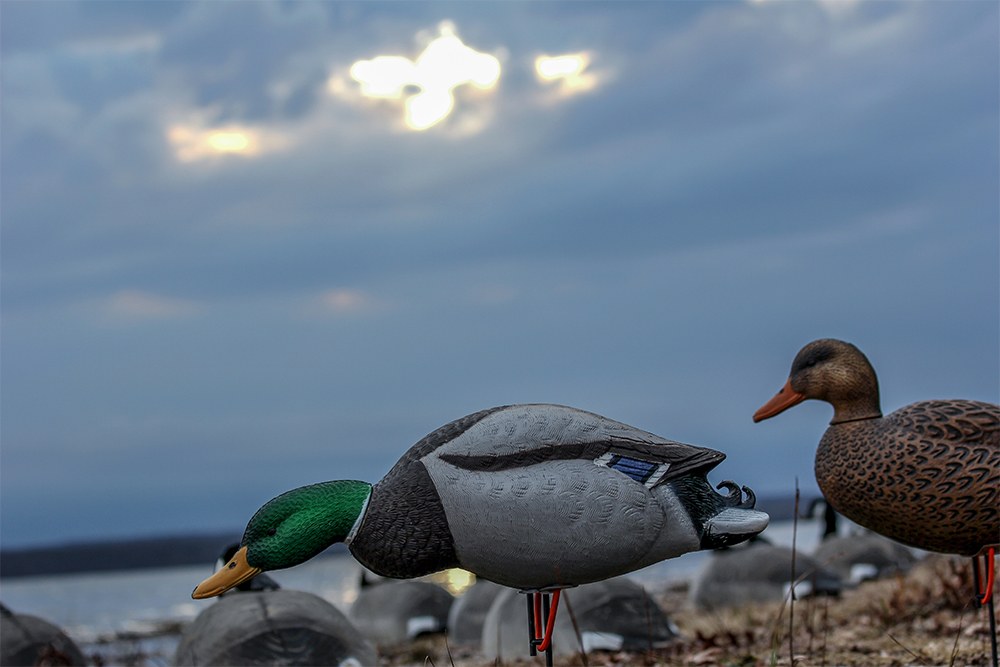by Bret Amundson |
Scouting, early set up, and the right decoys can lead to great success in the field.
A field hunt for mallards is arguably the most exciting waterfowl hunt possible—snow goose tornadoes and timber hunts excluded. Although mallards work similar to snows when they’re in big flocks and watching them spin closer and closer can get the heart pumping as much as greenheads dropping into the trees.
The number one rule of field-hunting success is like anything else: Get out and scout. Putting miles on the truck and boots to find the birds will always be my biggest advice.
Scouting for mallards isn’t easy. They don’t show themselves much during the day. Just before sunrise, and just before sunset, are your best times to be on the road. You’ll want to find a decent amount of birds in multiple groups, because inevitably, they’ll come in big groups in the morning as well. If you don’t have multiple flocks, it could be a one and done situation.
And honestly, sometimes that’s the way it is. In fact, we’ve had all the mallards show up 10 minutes before legal shooting time, land, get nervous, and leave before we could fire a shot.
That brings me to my second piece of advice: Get set up early. Mallards tend to start showing up while most guys are still putting decoy stakes in the ground. If they show up before legal shooting time and you’re ready to go, you might get them to land or at least keep spinning around without busting you and bugging out. I like to be set, with everyone comfortable in their layout blinds, at least 20 minutes before legal shooting time.
As far as decoys go, a well-known secret is that a Canada goose decoy can be the best mallard decoy. I’ve even called in mallards using a goose call.When it comes to numbers, you can never have too many decoys in the spread. But, you don’t need 1,000 of them if you are on the “X” where you know the birds will be. Earlier this year, I set about an eight-dozen decoy spread that included Canada geese and some mallard full bodies. A simple spread for the solo hunt I was on, and it worked flawlessly. If I’m not in the field that the birds worked the night before, I will set as many decoys as possible to try and traffic birds in the area.
While goose hunters might go blue in the face running their short-reeds, duck hunters don’t need the lung capacity of an Olympic swimmer to call in ducks. Some light quacks to get their attention, and a feeder chuckle when they’re working the spread, are all you need. In other words, don’t overcall.If a spread looks right, they’ll spin and spin and spin and should give you a good opportunity. Of course, these are wild birds, so I will try different notes and combinations to see what makes them react best.

The Storm Front ™ 2 Full Body Mallard decoy, by Flambeau Outdoors, can get you in position to get those ducks in range, even when you might not know exactly where they’ll be. These full bodies are Flambeau’s banner decoy series that takes its name from the most-anticipated phenomenon of the waterfowl season, the arrive of fresh birds to your spread with a storm front. These decoys are carved by renowned master carvers Tom Christie, Dave Van Lanen, and Rich Smoker, providing unsurpassed realism and unequivocal durability. With the polymer blend for longevity to the ultra-visible, ultra-violet UVision paint technology, the Storm Front 2 decoys are a deadly fusion of what birds need and the hunter demands.
To summarize, field hunting mallards isn’t rocket science. But with ample scouting, early set up, the right decoys, light calling, and a dose of good luck, you can have a mallard hunt as exciting as they come.